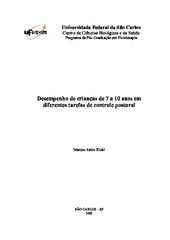| dc.contributor.author | Kishi, Marcos Seizo | |
| dc.date.accessioned | 2016-06-02T20:19:04Z | |
| dc.date.available | 2009-09-01 | |
| dc.date.available | 2016-06-02T20:19:04Z | |
| dc.date.issued | 2005-03-04 | |
| dc.identifier.citation | KISHI, Marcos Seizo. Desempenho de criança de 7 a 10 anos em diferentes tarefas de controle postural.. 2005. 108 f. Dissertação (Mestrado em Ciências Biológicas) - Universidade Federal de São Carlos, São Carlos, 2005. | por |
| dc.identifier.uri | https://repositorio.ufscar.br/handle/ufscar/5202 | |
| dc.description.abstract | The aim of this study was to describe the effect of different tasks on the postural control of
children aged between 7 and10 years old. Twenty-one children, divided into two age groups
of 7-8 and 9-10 years old, participated in the study by performing 5 tests from the Balance
Master System. The purpose of the first test was to verify the ratio of weight bearing to the
levels of articular stress conferred by different degrees of knees flexion, and, according to
ANOVA test, there were no differences either between the groups or among the conditions.
Both the second and the fifth tests aimed to verify the influence of sensory cues on the
postural control quantified by the sway speed; the former provided somatosensory and visual
cues, and the latter, vestibular and visual cues. Kruskal-Wallis statistic test was applied to
these two tests, and no differences were found between the groups. However, the groups
showed distinct behaviors in relation to the conditions. The second test indicated that the
alteration in somatosensory input resulted in maximal instability of the postural control, while
the fifth one verified maximal instability when vestibular input was altered. The aim of the
third test was to identify the response of the control motor components during the
performance of tasks that involve intentional movement of the center of body mass toward the
target. The group of 7-8-year-old children showed better performances in Endpoint Excursion
(EPE) and Movement Velocity (MV), and it seems to be related to cognitive aspects of the
task. The forth test aimed to relate the variables of gait to the maintenance of the stability
following its achievement, and, although no differences were found between the groups, it
was verified positive correlations between anteroposterior body sway and step width as well
as progression velocity. Regarding the postural control, it is possible to conclude that the age
influenced the variables EPE and MV, since the age group of 7-8 years old showed better
performances. In addition, postural as well as motor control of the children was influenced by
sensory cues of the tasks. | eng |
| dc.description.sponsorship | Universidade Federal de Sao Carlos | |
| dc.format | application/pdf | por |
| dc.language | por | por |
| dc.publisher | Universidade Federal de São Carlos | por |
| dc.rights | Acesso Aberto | por |
| dc.subject | Postura humana | por |
| dc.subject | Postura - criança | por |
| dc.subject | Controle motor em crianças e lactentes | por |
| dc.subject | Desenvolvimento infantil | por |
| dc.title | Desempenho de criança de 7 a 10 anos em diferentes tarefas de controle postural. | por |
| dc.type | Dissertação | por |
| dc.contributor.advisor1 | Tudella, Eloisa | |
| dc.contributor.advisor1Lattes | http://lattes.cnpq.br/3207258034860219 | por |
| dc.description.resumo | O presente estudo teve por objetivo descrever o impacto de diferentes tarefas no controle
postural de crianças 7 a 10 anos, divididas em grupos etários de 7-8 e 9-10 anos. Para tanto,
21 crianças participaram da realização de 5 testes do Sistema Balance Master. No primeiro
teste, objetivou-se verificar a proporção da descarga de peso frente a níveis de estresse
articular conferida por graus de flexão de joelhos, e o teste ANOVA não constatou diferenças
entre os grupos e as condições. O segundo e o quinto testes, tinham por objetivo verificar a
influência da manipulação das informações sensoriais sobre o controle postural, quantificado
pela velocidade de oscilação postural, sendo que o segundo teste manipulou as informações
somatossensoriais e visuais, enquanto que o quinto teste manipulou as informações
vestibulares e visuais. Em ambos os testes aplicou-se o teste estatístico de Kruskal-Wallis.
Não foram verificadas diferenças inter grupos, mas, comportamentos diferentes dos grupos,
frente às condições, puderam ser verificadas. Com relação às manipulações de informações
sensoriais, verificou-se, no segundo teste, que a alteração da informação somatossensorial
provocou maior desestabilização do controle postural, enquanto que no quinto teste foi
verificada maior desestabilização diante da manipulação vestibular. O terceiro teste teve como
objetivo verificar a reação de componentes do controle motor durante a realização de tarefas
envolvendo a movimentação consciente do centro de massa em direções específicas. O grupo
de 7-8 anos obteve melhor desempenho nas variáveis Último Ponto e Velocidade de
Movimento, e, sugere-se que esse desempenho esteja relacionado a aspectos cognitivos
envolvidos na tarefa. O quarto teste teve por objetivo relacionar variáveis relacionadas à
marcha com a manutenção da estabilidade postural, após a sua realização. Não houve
diferenças entre os grupos, porém, a oscilação postural final no sentido ântero-posterior
obteve correlação positiva com a largura do passo e com a velocidade de progressão.
Considerando os aspectos relacionados ao controle postural, podemos concluir que, na faixa
etária de 7-10 anos, o fator idade influenciou em duas variáveis do terceiro teste, sendo que o
grupo de 7-8 anos obteve melhores resultados. Conclui-se que o controle postural e motor, das
crianças participantes, foram influenciados pela manipulação da informação sensorial nas
tarefas desenvolvidas. | por |
| dc.publisher.country | BR | por |
| dc.publisher.initials | UFSCar | por |
| dc.publisher.program | Programa de Pós-Graduação em Fisioterapia - PPGFt | por |
| dc.subject.cnpq | CIENCIAS DA SAUDE::FISIOTERAPIA E TERAPIA OCUPACIONAL | por |
| dc.contributor.authorlattes | http://lattes.cnpq.br/2333440373816942 | por |
